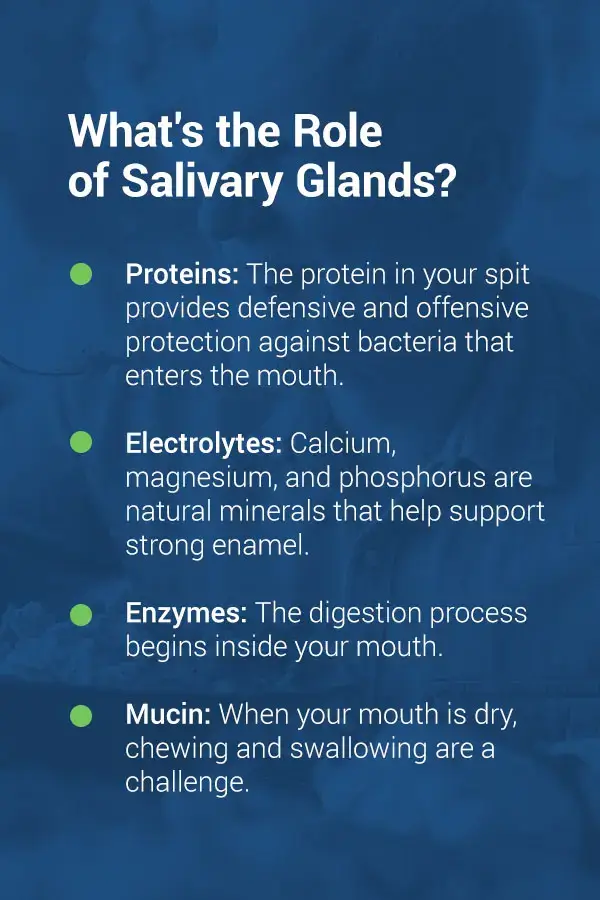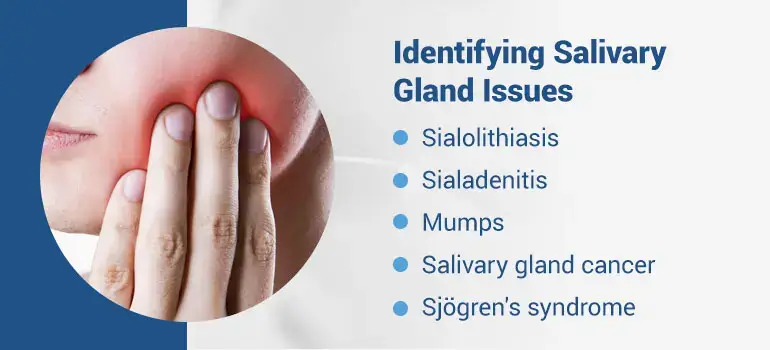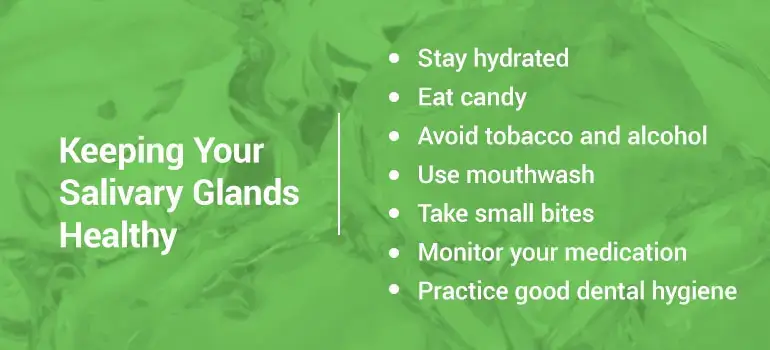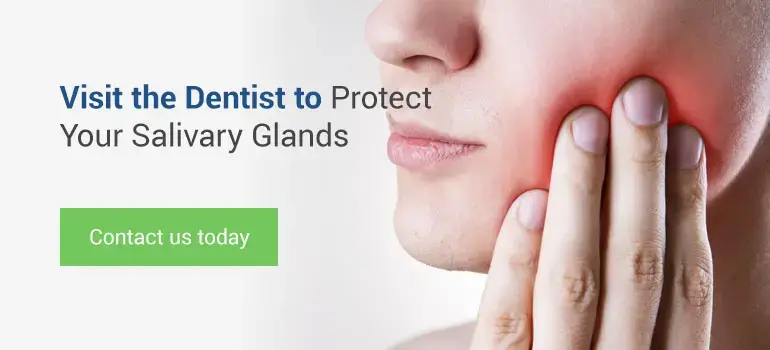
Did you know you have several hundred salivary glands in your mouth and throat? Salivary glands play an essential role in everyday processes, yet not many people discuss them. They keep your mouth moist to promote healthy teeth and gums and help you digest food.
When your salivary glands are out of order, it can lead to other health problems. Issues with your salivary glands cause uncomfortable symptoms and are sometimes a sign of serious diseases.
AZ Family Dental has extensive information about salivary glands and how to take care of them to maintain your health.
What’s the Role of Salivary Glands?

Healthy salivary glands produce 0.5-1.5 liters of saliva every day. That’s nearly two quarts of spit! Saliva is crucial for your oral and digestive health. It coats your mouth to protect your teeth from bacteria and helps break down your food, so it’s easier to chew, swallow, and digest. Saliva also helps heal your mouth when it’s injured.
Mouth openings called ducts transport saliva from your salivary glands into your mouth and throat. Saliva is 99% water, but the remaining 1% contains essential minerals that serve a unique purpose to keep your body healthy. Salivary glands produce the following components to help your body function properly:
- Proteins: The protein in your spit provides defensive and offensive protection against bacteria that enters the mouth. It kills some bacteria and forms a barrier around your teeth to shield against the rest.
- Electrolytes: Calcium, magnesium, and phosphorus are natural minerals that help support strong enamel. Enamel is the outer layer of the tooth that protects against cavities and tooth decay.
- Enzymes: The digestion process begins inside your mouth. Enzymes from your saliva spark chemical reactions to break down the starches and fats that you consume.
- Mucin: When your mouth is dry, chewing and swallowing are a challenge. Mucin lubricates your mouth so you can safely eat without choking.
Major Salivary Glands
While there are hundreds of microscopic salivary glands throughout your mouth and digestive tract, most of your saliva is produced by three pairs of major salivary glands. Here are the three major salivary glands and their functions:
1. Parotid Glands
The parotid glands are the largest of the three pairs. A healthy parotid gland weighs about half an ounce on average, and you have one on each side of your head. They’re beneath the skin on the side of your face in front of your ears. The parotid gland creates saliva that drains into the mouth through a duct above your upper second molar.
The parotid gland has two parts that are woven around the facial nerve. Major arteries and veins also surround it. Surgeons must operate on the parotid gland with precision to avoid damaging these vital structures.
2. Submandibular Glands
The submandibular glands are located just beneath the jaw on either side of the chin. They’re about half the weight of the parotid gland and are similar in size to a walnut. It also has two parts surrounded by vital nerves that control your facial movements. The saliva created by the submandibular glands enters the mouth through a duct below the tongue.
3. Sublingual Glands
The smallest major salivary pairs are the sublingual glands. They’re below the mouth on each side of your tongue. A healthy sublingual gland resembles an almond in shape and size. The saliva they generate flows through several ducts into the bottom of your mouth.
What Causes Salivary Gland Issues?
When salivary glands are blocked or damaged, it can lead to painful and inconvenient side effects. Many different factors can contribute to salivary gland issues.
Blockages
Obstructions are a common cause of salivary gland swelling and discomfort. The ducts can become constricted or twisted, which makes it challenging for saliva to flow through. Approximately 12 out of every 1000 adults experience duct blocking salivary stones. When crystallized saliva builds up around your ducts, it forms salivary stones called sialoliths that prevent your glands from draining.
When you eat, your glands will continue to produce saliva that has no way of escaping. The trapped saliva causes your glands to swell and become painful. Over time, a blocked gland will likely become infected.
Infection
The medical term for salivary gland infections is sialadenitis. This condition is most common in the parotid and submandibular glands. The elderly and chronically ill with dry mouth or dehydration symptoms are the most susceptible to sialadenitis, but it can affect anyone, including infants.
When a duct becomes blocked, the gland is prone to infection-causing bacteria from inside the mouth. Infected lymph nodes near the salivary glands can also spread bacteria. An infected gland will become swollen and painful and may drain an unpleasant discharge into the mouth.
Viruses
Viral illnesses like the flu can infect the salivary glands and cause swelling and reduced saliva production. Mumps is the most common viral salivary gland infection caused by the paramyxovirus. Paramyxoviral infections develop in the parotid glands causing inflammation and pain while chewing and swallowing. Mumps and other viral conditions cause swelling to occur in both glands on each side of your face.
Other viruses that affect the salivary glands include:
- Epstein-Barr virus (EBV).
- Cytomegalovirus (CMV).
- Echovirus.
- Coxsackievirus.
- Herpes.
- Human immunodeficiency virus (HIV).
Tumors
The salivary glands can develop many different kinds of tumors. Most tumors that form are benign, but some cancerous tumors also occur.
Benign tumors grow slowly and are often painless. Warthin tumors, adenomas, oncocytomas, and benign mixed tumors are noncancerous and usually cured through surgery. Although uncommon, the mass may grow back if a small piece is left. In rare cases, benign tumors may become cancerous if they’re not removed.
Different types of cancerous or malignant tumors can form in the salivary glands. While the risk of developing salivary gland cancer is higher for men and older adults, it can affect anyone. Cancerous tumors typically expand rapidly, potentially causing pain and loss of movement in the surrounding area.
Diseases
Various health conditions can lead to issues with the salivary glands. Sjögren’s syndrome is a chronic autoimmune disease that causes white blood cells to attack moisture-producing glands that create tears, oils, sweat, and saliva. When they attack the salivary glands, it leads to inflammation, tenderness, and dry mouth.
Sjögren’s syndrome is common in middle-aged women and people with lupus and rheumatoid arthritis. Diabetes and alcoholism can also lead to enlarged salivary glands and other related symptoms.
Other Factors
Your diet and medications can also lead to salivary gland issues. Dehydration thickens the saliva, which increases the risk of clogged ducts and salivary stones. Malnutrition and eating disorders can lower the demand for saliva, causing the salivary glands to swell. Some allergy, blood pressure, and psychiatric medications can decrease saliva production, increasing the risk of developing salivary gland issues.
Your lifestyle choices can also lead to salivary conditions. People who play wind instruments or blow glass as a career or hobby often develop salivary gland disorders. Smoking and drinking alcohol can also impact the health of your salivary glands.
Identifying Salivary Gland Issues
The most common signs of salivary gland issues are swelling and pain in the surrounding area. However, when your glands aren’t functioning correctly, it can cause many other ailments. The following symptoms can help you identify your salivary gland issues:
- Sialolithiasis: When you have a salivary stone, you can often feel a lump under your tongue near the opening of the duct. You may also experience increased pain while eating or drinking.
- Sialadenitis: A bacterial infection causes your salivary gland to become swollen and stiff. You may feel a firm lump in your cheek or under your chin. Fever is common with bacterial infections. You may also smell or taste unpleasant drainage from the infected gland.
- Mumps: Swollen glands on one or both sides of the face are the primary sign of mumps. They cause challenges with chewing and swallowing. Other symptoms of mumps include headache, fever, fatigue, loss of appetite, and muscle aches.
- Salivary gland cancer: The most common symptom of salivary gland cancer is a lump in the mouth, neck, or jaw that continues growing or doesn’t go away. The tumor can cause pain or weakness in the surrounding area. You may also experience difficulty moving your jaw and swallowing.
- Sjögren’s syndrome: This immune system disorder can affect many areas of the body. The most common symptoms are dry eyes and dry mouth. The lack of saliva can lead to tooth decay and gum disease. Some people also experience swelling and discomfort in their salivary glands.

Diagnosis for Salivary Gland Disorders
Depending on the condition, a salivary gland disorder is typically diagnosed through a physical exam and diagnostic testing if needed. The doctor will look inside your mouth and feel around the glands for swelling or tumors. A dental x-ray can capture a better view of a salivary stone or obstruction.
If the doctor suspects you have a tumor or autoimmune disorder, they’ll likely request a CT scan or MRI to see what’s happening inside your glands. They may take saliva and blood samples to test for Sjögren’s syndrome. They may also screen a biopsy of your salivary glands for cancer and other diseases.
Treatment for Salivary Gland Conditions
The treatment for salivary gland conditions varies depending on the cause of the problem. Some issues will clear up on their own, while others require medication or surgery. Some common treatments you can expect for most salivary gland disorders include:
- Fluids and antibiotics: Bacterial infections respond well to fluids and medication. A warm compress helps relieve discomfort and draw blood flow to your salivary gland to promote healing.
- Rest: Most viral illnesses don’t require special medication. Your immune system can fight them off with time and rest. Increased fluids and a fever reducer can help your body heal itself.
- Stone removal: The procedure to remove salivary stones depends on their size and where they form. Small stones will often pass through on their own without medical treatment. If the stone is close to the opening of a duct, a doctor can remove it with a simple procedure. Some doctors will use ultrasound waves to break a large stone into smaller pieces. Stones that are lodged deep inside your duct may require surgery.
- Surgery: If a tumor forms inside your salivary gland, doctors typically remove it, whether it’s benign or malignant. In some cases, doctors may choose to remove the entire gland. If the mass is cancerous, most people will undergo radiation treatment after surgery.
- Prescription medication: You can treat chronic salivary gland diseases, dry mouth, and autoimmune disorders with prescription medication. If medication for another condition is causing your salivary gland disorder, doctors can try switching you to a different one to relieve your symptoms.
Keeping Your Salivary Glands Healthy
Now that you know all the facts about salivary glands, you can see why it’s so important to take care of them. Here are some preventive measures you can take to keep your salivary glands healthy:
- Stay hydrated: Drinking fluids throughout the day will help keep your mouth moist and healthy and prevent harmful bacteria from building up near your salivary ducts.
- Eat candy: It may come as a shock that eating candy can actually be good for you. As long as it’s sugar-free, sucking on hard candy or chewing gum can help stimulate your salivary glands to keep them clean and healthy.
- Avoid tobacco and alcohol: Smoking and drinking alcohol causes dry mouth, leading to problems with your salivary glands. Dry mouth reduces the flow of saliva, which increases your chances of getting an infection or salivary stones.
- Use mouthwash: Hydrating rinses that are formulated to treat dry mouth will help keep your mouth lubricated. Anti-bacterial mouthwash can help rinse away harmful microorganisms. Avoid using mouthwashes with alcohol that increase symptoms of dry mouth.
- Take small bites: Eating your food in small bites increases your saliva production. Chew your food thoroughly so you can exercise your salivary glands as much as possible.
- Monitor your medication: Reach out to your doctor if your medications are causing dry mouth. This seemingly minor symptom can lead to painful salivary gland disorders. They may be able to switch you to another medication.
- Practice good dental hygiene: Maintaining a consistent oral care routine will help keep your mouth clean and free of infection-causing germs and bacteria. Dentists recommend brushing two times per day, flossing daily, and getting a thorough dental cleaning every six months.

Visit the Dentist to Protect Your Salivary Glands
The saliva produced by your salivary glands keeps your smile strong and healthy. Your dental care routine is key to maintaining your salivary glands and protecting your teeth from cavities and gum disease. At AZ Family Dental, we’ll provide thorough dental cleanings and monitor your oral health for signs of dry mouth and salivary gland disorders.
We offer a full array of dental services to keep you healthy and happy. Contact us today to schedule your routine cleaning.

